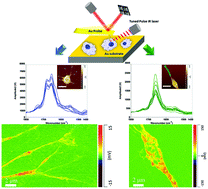AFM-IR probing the influence of polarization on the expression of proteins within single macrophages†
Abstract
Macrophages are essential in innate immunity and are involved in a variety of biological functions. Due to high plasticity, macrophages are polarized in different phenotypes depending on different microenvironments to perform specific functions. Although many studies have focused on macrophage polarization, few have explored the polarization characteristics of macrophages at the subcellular level, even at nanoscale resolution. Here, we utilize AFM-based infrared spectroscopy (AFM-IR) to investigate the influence of an inducer on the expressed proteins of M1/M2 macrophages (induced by LPS and IL-13, respectively). The results from AFM-IR combined with principal component analysis revealed that the characteristic proteins within M1 contain about 35% antiparallel β-sheets (due to the high expression of TNF-α), while the proteins within M2 are made up of approximately 38.8% α-helices. The corresponding nanoscale chemical mapping demonstrates a remarkably heterogeneous distribution of expressed proteins inside single macrophages. Beside the biochemical properties, the biomechanical properties of macrophages were found to be softened in response to the polarization process.



 Please wait while we load your content...
Please wait while we load your content...